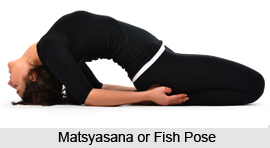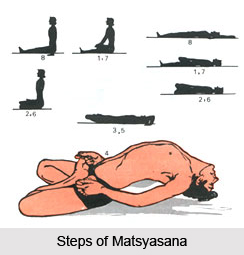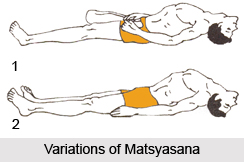 Matsyasana is a cultural asana mentioned in several noted Hatha Yogic texts, wherein the practitioner assumes a pose suggestive of floating like a fish.
Matsyasana is a cultural asana mentioned in several noted Hatha Yogic texts, wherein the practitioner assumes a pose suggestive of floating like a fish.
Meaning of Matsyasana
Matsya means fish in Sanskrit. Unlike other asanas which are named after the resemblance of the body to a particular creature during the final position of the asana, the body does not resemble a fish during this asana. The asana is suggestive of the quality of floating like a fish - a state of mind and body induced by assuming this posture.
Yoga Texts and Matsyasana
Matsyasana has been mentioned or described in various classical yoga texts. It was first mentioned in the Brihan Naradiya Purana, a Puranic text compiled around 850 AD. It was latermentioned intermittendly in various Puranic texts until being described in the Hatha Yoga Pradipika (1400 AD), the foundatinal text of Hatha Yoga. It was described regularly in the Yoga Upanishads (1400 AD) and in later texts like the Gherand Samhita and the Shri Tattva Nidhi. In sum, Matsyasana has had an unusually long history, and is hence a major yoga asana.
Practice of Matsyasana:
 * Sit in Padmasana and slowly take the help of the elbows to lie down on the back. Then slowly lie on the back completely.
* Sit in Padmasana and slowly take the help of the elbows to lie down on the back. Then slowly lie on the back completely.
* Now with the help of elbows or palms bend the head backward and place middle of the head on the ground.
* Catch hold of the toes with the index fingers and place the elbows on the ground.
* While returning to original position, release the toes and taking the help of the hands straighten the head.
* Now taking the help of elbow sit in Padmasana.
Effects of Matsyasana
* Stretches the deep hip flexors (psoas) and the muscles (intercostals) between the ribs.
* Stretches and stimulates the muscles of the belly and front of the neck.
* Stretches and stimulates the organs of the belly and throat.
* Strengthens the muscles of the upper back and back of the neck.
* Improves posture.
* Jalandhara Bandha in Sarvangasana pressurizes the thyroids and pituitary glands but in Matsya Bandha these glands are stretched. These opposite processes help improve the circulation in these glands assuring healthy functioning.
* Also the thigh & abdomen muscles are stretched systematically.
Precautions during Matsyasana
* Do not bend the neck backward with a jerk.
* The weight over the head should be taken out slowly.
* The support of the hands should be removed only when the head is completely ready to bear the weight.
* While releasing the position, one should avoid jerks and speedy movements.
 * Maintain the asana until it is bearable and pleasant.
* Maintain the asana until it is bearable and pleasant.
* Do not move or pull or turn the neck while in the position.
* Do not remove the support of the elbows to neck.
The asana is not recommended in the case of high or low Blood pressure, migraine, insomnia and serious lower-back or neck injury.
Beginners sometimes strain their neck in this pose. If any discomfort is felt in the neck or throat, either lower the chest slightly toward the floor, or put a thickly folded blanket under the back of the head.



